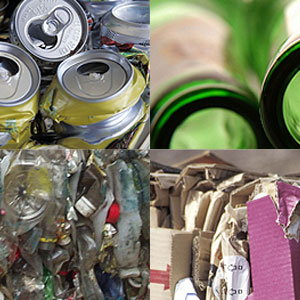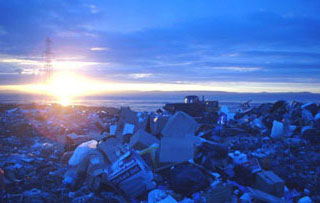Welcome
Prosiect Gwyrdd is a partnership between, Caerphilly Borough County Council, The County Council of the City and County of Cardiff, Monmouthshire County Council, Newport Council and Vale of Glamorgan Council The combined municipal waste of the five authorities makes up 40% of the total municipal waste of Wales. Prosiect Gwyrdd is committed to looking for the best environmental, cost effective and practical solution for waste after recycling and composting has been maximised in each area.
All authorities are committed to recycling and composting and meeting the challenging targets ahead of us. The Welsh Assembly Government has outlined a 70% recycling and composting rate by 2025, and each authority is striving to meet this target.
The contract has now been signed by Cardiff Council as the Lead Authority and a legal agreement is in place through a (Joint Working Agreement) between the other partner authorities. The Project has gone through a robust (procurement) process and Viridor has been awarded the contract.
Joint Working Agreement
Procurement
Preferred Bidder

Did you know?
- The decomposition of waste in the absence of air, gives off methane. As a molecule, methane is 23 times more potent as a green house gas than carbon dioxide.
- In the UK approximately 2.4 million tonnes of methane is release each year. Emissions from municipal solid waste landfill sites account for 27% of the national total.
- Methane is recovered from landfill operations, but the collection rate at best is only 10%. This has to be compared to residual waste treatment plants where the collection rates are between 40-60%.
Landfill has historically been the chosen method to deal with waste. This cannot continue and a solution has to be found.
- A third of all the food we buy ends up being thrown away.
- In Wales we throw away 330 000 tonnes of food waste each year.
- Organic waste, such as fruit, vegetables and tea bags make up to 38% of the contents of the average dustbin.
- An estimated 6.7 million tonnes of household food waste is produced each year in the UK, most of which could be eaten.
Each of the local authorities in Prosiect Gwyrdd are committed to divert as much food waste as possible for composting and plans are underway to implement new schemes.
- Every year in the UK, we throw away 28 million tonnes of rubbish from households. This weighs the same as three and a half million double decker buses.
- Every day 80 million food and drink cans end up in landfill.
- In the UK, we fill about 300 million square metres of land with rubbish each year.
- We produce 20 times more plastic in the UK than we did 50 years ago.
Each of the local authorities in Prosiect Gwyrdd is committed to recycling and composting as much waste as practically possible. Residents have a duty to reduce and reuse as much waste as possible so that we can all improve the environment. Waste is everyone's problem.
Wyddech chi?
- Mae gwastraff sy'n dadelfennu heb aer yn cynhyrchu methan. Fel moleciwl, mae methan yn gallu cynhyrchu 23 gwaith yn fwy o nwyon ty gwydr nag yw carbon deuocsid.
- Yn y DU, rhyddheir oddeutu 2.4 miliwn o dunelli o fethan bob blwyddyn. Mae allyriadau o wastraff dinesig solid mewn safleoedd tirlenwi yn 27% o'r cyfanswm cenedlaethol.
- Cesglir methan o weithredoedd tirlenwi, ond 10% ar y mwyaf yw'r gyfradd gasglu. Rhaid cymharu hwn â gwaith trin gwastraff gweddilliol lle mae'r cyfraddau casglu'n llawer uwch (gweler y tudalen dewisiadau).
Tirlenwi yw'r modd traddodiadol o ddelio â gwastraff. Ni all hyn barhau ac mae'n rhaid cael hyd i ateb arall.
- Mae un rhain o dair o'r bwyd a brynwn yn cael ei daflu yn y pen draw.
- Yng Nghymru, rydym yn taflu 330,000 tunnell o wastraff bwyd bob blwyddyn.
- Gwastraff organig, megis ffrwythau, llysiau a bagiau te, yw hyd at 38% o gynnwys bin arferol.
- Cynhyrchir oddeutu 6.7 miliwn o dunelli o wastraff bwyd cartref yn flynyddol yn y DU, a gellir bod wedi bwyta'r rhan fwyaf ohono.
Mae pob un o'r awdurdodau lleol sy'n rhan o Broject Gwyrdd wedi ymrwymo at ddargyfeirio cymaint o wastraff bwyd â phosibl i gael ei gompostio. Mae cyllid wedi'i glustnodi gan Lywodraeth y Cynulliad ar gyfer pob awdurdod.
- Rydym yn taflu 28 miliwn o dunelli o sbwriel o gartrefi bob blwyddyn yn y DU. Mae hyn yn pwyso'r un faint â thua tair miliwn a hanner o fysus deulawr.
- Mae 80 miliwn o dunelli o ganiau bwyd a diod yn mynd i safleoedd tirlenwi bob dydd.
- Yn y DU rydym yn llenwi tua 300 miliwn o fetrau sgwâr o dir gyda sbwriel bob blwyddyn.
- Rydym yn cynhyrchu 20 gwaith mwy o blastig yn y DU nag oeddem yn ei wneud hanner canrif yn ôl.
Mae pob un o'r awdurdodau lleol sy'n rhan o Project Gwyrdd wedi ymrwymo at ailgylchu a chompostio gymaint o wastraff ag sy'n bosibl. Mae dyletswydd ar breswylwyr i leihau ac ailddefnyddio gymaint o wastraff â phosibl er mwyn i ni gyd wella'r amgylchedd. Mae gwastraff yn broblem i bawb.
Figures
Recycling and composting rates 2015/16
Caerphilly: 61.9%
Cardiff: 58.2%
Monmouthshire: 61.9%
Newport: 57.1%
Vale of Glamorgan: 64.5%

What is the national stance on waste in Wales?
The National Waste Strategy for Wales, ‘Wise about Waste’, identifies policies for waste management and targets and actions to meet them. Primary targets identified for waste and its management in Wales include:
- Reducing the amount of waste produced by public bodies.
- Reusing as much waste as possible.
- Recycling and composting waste that is not reused and meeting EU targets.
- Improving the segregation of hazardous household waste.
Secondary targets for waste in Wales include:
- Stabilisation and reduction of household waste.
- Encouraging businesses to join the public sector in creating waste minimisation targets.
- Diverting waste and particularly biodegradable waste from landfill.
- Reducing the amount of hazardous waste produced.
- Reusing and recycling construction and demolition waste wherever possible.
After recycling and composting has been maximised, there is always going to be left over waste which cannot be practically recycled (residual waste). Landfill has historically been the chosen method to manage waste, but this cannot continue.
Why:
- The European Union Landfill Directive restricts the amount of biodegradable municipal waste that can be land filled.
- Land suitable for landfill operations in the region is fast running out.
- Landfill produces methane, which is one of the main contributing factors to climate change.







